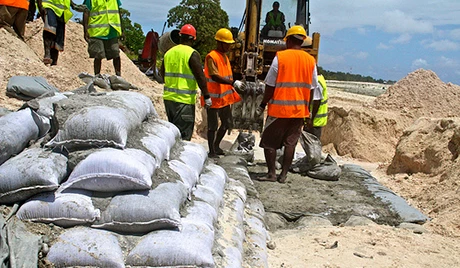Late last month, I retired after spending more than 30 years in the climate arena, the last decade as a principal climate change specialist at the International Finance Corporation.
During the span of my career, climate change has moved from the sidelines to be recognized as a serious development challenge. And while we’re still far from achieving the international commitments needed to avoid potentially dangerous and even catastrophic climate events, much has been accomplished.
Scientists have reached near-consensus about climate change and its impacts. We’ve also seen the creation of several significant donor-supported climate funds, as well as a steady increase in policy and financial support for climate-friendly technologies.
In one critical respect, however, we need more progress: making the private sector a partner in helping nations build resilience and adapt to climate change.
The business community needs to be our partner as we build resilience against and adapt to climate change. Yet to date, adaptation discussions inside and outside official climate negotiations have had surprisingly little business engagement.
The focus thus far has been almost entirely on what governments need to do, and who should pay. In some quarters, business interest has even been viewed as inappropriate competition for scarce resources.
This is changing in a few countries, but not yet in developing nations where the biggest needs exist. Adaptation planning and investments must include the private sector – and the sooner this happens, the better.
Engaging the private sector is essential for multiple reasons. It can mobilize financial resources and technical capabilities, leverage the efforts of governments, engage civil society and community efforts, and develop innovative climate services and adaptation technologies.
Private entities dominate many investments that are critical to adaptation, such as the location and design of buildings and other infrastructure investments.
Private-sector corporations also develop – and often dominate – the design and delivery of many adaptation services such as weather observation technology and early warning systems. Drought-resistant seeds and other agricultural products, along with water management infrastructure and technologies, also tend to fall within their purview.
Although insurance tends to be much less available and relevant to investment in developing nations, there are already significant examples of “Cat” bonds and other products that spread the risk and speed the recovery of countries after natural disasters.
As the largest victims of natural disasters, corporations are also in a position to spread climate awareness and rally political support for climate action. Finally, and in some ways most important, the private sector must take on a bigger, if not the dominant, financing role for climate adaptation in all but the poorest countries if we are to prepare sufficiently for the challenges that lie ahead.
So what do we mean by partnering with the private sector in adaptation projects? In a recent article I co-authored with Bonizella Biagini, the Global Environment Facility’s adaptation manager, we review the concept and provide some highlights:
- In partnership with the International Finance Corporation, a private port facility in Colombia identified its vulnerability to long-term sea level rise. The company modified and increased its planned investments to anticipate and incorporate greater structural integrity. It subsequently announced it will make similar enhancements to all eight ports that it owns and manages.
- Munich Re, a major insurance company, has made analysis and management of the impacts of natural disasters a central basis for selecting and working with clients – not simply spreading risks, but making their clients more resilient to reduce losses. This improves the company’s profitability and helps clients avoid business interruption.
- In very poor countries with weak business development, adaptation programs can help channel development into less vulnerable areas. In Sierra Leone, for example, small and medium-sized enterprises offered affordable water harvesting, storage and distribution systems that helped communities withstand projected changes in rainfall patterns and intensity – all activities that were also supported by existing adaptation funds.
Highly innovative adaptation products and services developed and marketed by private companies are already improving climate resilience.
Low-cost weather observation systems placed on cell phone towers, for example, are a fraction of what radar systems cost and often work as well or better in many locations. Companies that offer farmers highly targeted weather and soil information, meanwhile, can help improve yields and reduce vulnerability to climate change.
Of course, governments play a key role to make businesses more aware of climate risks and boost private sector engagement through partnerships. The IFC and the European Bank for Reconstruction and Development have been working with the government of Turkey and its business associations to do just that.
A recent ambitious effort along these lines is also taking place in New York City, where city officials are inviting insurance companies to discuss coastal protection investments. City officials recognize that since insurers will be among the major beneficiaries, they may be asked to share the costs of the major improvements required.
Efforts to engage the private sector in adaptation to climate change are beginning and must be accelerated. Public policy should provide appropriate incentives for adaptation measures and, where necessary, regulation to avoid shifting risks to the public.
The financial community can help by recognizing the relevance of climate risk as a factor when it evaluates the expected future performance of companies, for example by offering climate leaders a financial premium.
These are all common-sense steps we must take with our private-sector partners as we prepare the world for the future.



Join the Conversation